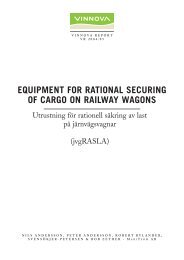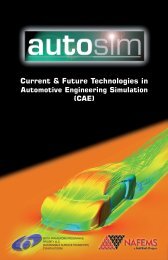WP3: Rail Passenger Transport - TOSCA Project
WP3: Rail Passenger Transport - TOSCA Project
WP3: Rail Passenger Transport - TOSCA Project
Create successful ePaper yourself
Turn your PDF publications into a flip-book with our unique Google optimized e-Paper software.
1 INTRODUCTION<br />
<strong>Rail</strong> passenger transport in the EU-27 totalled in 2007 a volume of 480 billion passenger-km,<br />
of which metros and trams made accounted for some 85 billion (EU, 2009). The market share<br />
was almost 8 % of the total passenger transport volume (in passenger-km, intra-EU), although<br />
with large variations between countries. In comparison some non-EU countries with well<br />
established and managed rail networks had considerably higher market shares; as shown in<br />
Table 1-1 below.<br />
Table 1-1<br />
Market shares in passenger transport by 2007 (passenger-km, pkm)<br />
Source: EU (2009): EU energy and transport in figures<br />
Road (car, bus) EU-27 83 %<br />
Air EU-27 9 %<br />
<strong>Rail</strong> EU-27 8 %<br />
cf. Switzerland 16 %<br />
Japan (approx) 32 % (2006)<br />
The market share for the rail mode declined in Europe for a long time until the mid 1990´s.<br />
After 1995 the decline has continued in the new member states (EU-12). However, in the old<br />
member states (EU-15) rail passenger transport has recovered to some extent, as result of new<br />
EU and national rail policies leading to investments in new trains and infrastructure, as well as<br />
the ongoing attempts of market liberalization. The most successful countries in this respect are<br />
France, UK and Sweden. Table 1-2 shows the development of the passenger rail market<br />
(excluding trams and metros) in some areas and countries in the period 1995–2007, in<br />
comparison to the average development of all transport modes.<br />
Table 1-2<br />
Development of passenger transport (passenger-km) in EU-27 in the<br />
period 1995-2007, rail and average of all modes. Source: EU (2009)<br />
Average all modes EU-27 +22 %<br />
<strong>Rail</strong> EU-27 +13 %<br />
EU-12 (new members, average) -33 %<br />
EU-15 (old members, average) +25 %<br />
France+UK+Sweden +52 %<br />
It is concluded that these new policies have started a revitalization of railways in Europe,<br />
although not yet in all member states.<br />
<strong>Rail</strong> passenger transport is widely considered to have low specific energy consumption and low<br />
direct or indirect greenhouse gas (GHG) emissions, in comparison to competing modes of<br />
transport. Although this is not always true, it is usually the case in electric train operations, in<br />
particular when the electricity mix is dominated by renewable primary energy sources or<br />
nuclear power. Diesel trains are usually not outstanding in energy and emission performance,<br />
but can in many cases also be very competitive in the energy and GHG respect.<br />
The main reasons for the low energy consumption are the following technical characteristics<br />
that are inherent in the basic rail technology:<br />
- Rolling resistance is very low with smooth hard wheels running on smooth hard rails.<br />
- Most vehicles in a long train are (to a large extent) shielded from the air drag by other<br />
vehicles ahead or behind.<br />
Deliverable D4 – <strong>WP3</strong> passenger 3
















